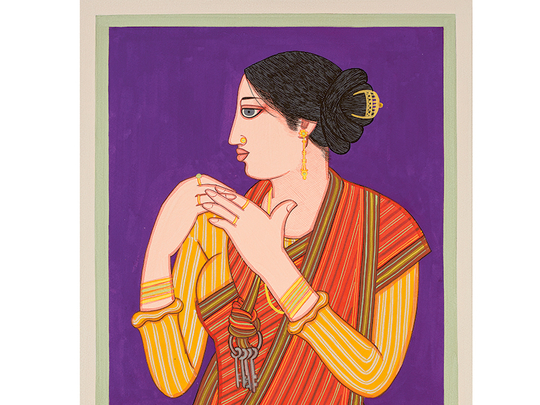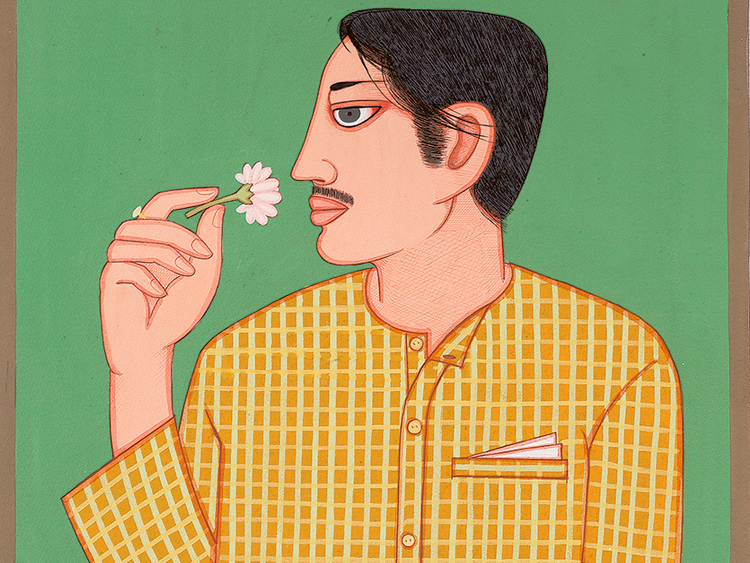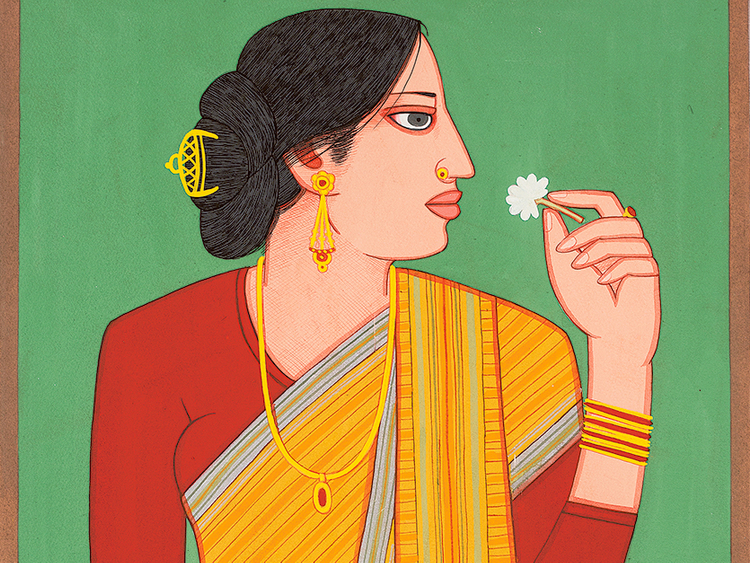
Well-known Indian artist Lalu Prasad Shaw belongs to a generation of artists from the famous Bengal School of Art who shook off the legacy of British colonial art and art education, and combined Indian and Western influences to develop a new aesthetic and new direction for post-colonial Indian art.
The septuagenarian is well-known as a printmaker and a painter. Interestingly, his prints are abstract and mostly black and white, but his paintings are figurative and done with a palette of bright colours.
Shaw is best known for his tempera on paper board paintings of Bengali women and men, dressed in traditional attire. His first show in Dubai, “A Dual Discourse”, features his signature paintings of women and couples, and a series of paintings of the Hindu deity Ganesha.
The graceful forms are outlined on colour-washed backgrounds, with attention to details such as the folds and patterns on the handloom saris and dhotis, every strand of hair, and elements in the surroundings. The men and women look elegant and serene, absorbed in their own world and the routine of domestic life.
In some paintings the presence of symbols such as an apple, flowers and butterflies tell stories about the dreams and desires of the women.
We spoke to the artist about his artistic journey. Excerpts:
What are the elements that influenced your distinctive style of painting?
A a child, I often visited the area where the folk artists lived, and enjoyed watching them work. I was fascinated by the paintings they made for the backdrop of the idols they sculpted. The way they depicted deities and the two-dimensional character of the images influenced the treatment of figures, objects and space in my paintings. My art college followed a rigid Western-style curriculum, and we were discouraged from doing any creative experimentation. But later I tried to unlearn the rigid norms of academic art and began developing a style that stressed on the two-dimensionality of painting.
How did you get interested in printmaking?
In 1967 I joined the Society of Contemporary Artists in Kolkata, where I was introduced to printmaking. From 1966 to 1973, I devoted myself totally to printmaking. At that time there was no art market or commercial galleries, hence no pressure of competition, allowing us to experiment freely with various styles. During that time I experimented with abstract forms, stressing only the structural quality in my etchings and lithographs. My prints were well-received in India and abroad, and I won many awards, including the National Award in 1971. Another high point came in 1976, when I was invited to participate in the Inter-Graphic exhibition in East Germany and got the opportunity to meet well-known printmakers and to visit museums and art galleries.
How did the transition from abstract prints to figurative painting happen?
The transition happened after I started teaching graphic art at Kala Bhavan, Santiniketan. The atmosphere at Santiniketan, and the paintings of masters such as Nandlal Bose and Rabindranath Tagore, inspired me. I was particularly inspired by a set of ‘Company period’ tempera paintings titled “Lucknow Birds”, done in flat opaque wash of colours and clear graceful lines defining the forms and details. I created a series of paintings of birds and flowers in the same style. In those days I often came across makeshift photo-stalls, where people would be posing for their pictures. Seeing the different poses inspired me to paint human figures. My figurative paintings are essentially influenced by the paintings of the folk artists of Bengal, and Indian miniature paintings from the Mughal period.
Who are the people in your paintings?
These are middle-class Bengalis who are a part of my surroundings, and my life, so I can paint them from memory. My paintings are so simple that everybody can relate to them and enjoy them. There is no ‘ism’ in my work.
Why did you choose to work with tempera?
Although I started my career with oil paintings, I switched to tempera because I could not afford oil paints, or the large studio space required for oil painting. The nice thing about tempera is that some colours such as yellow ochre and Indian red are opaque; others such as cobalt blue and vermillion are semi-transparent; and some such as viridian are transparent. I start my layered paintings with opaque colours and finish with transparent colours.
Are these figures relevant in contemporary times?
There is a sense of nostalgia attached to these figures. But Bengali women are fond of saris and even today you will find women dressed in this manner. I am not interested in painting women in jeans.
Jyoti Kalsi is an arts enthusiast based in Dubai.
“A Dual Discourse” will run at The Fine Art Advisory, Business Bay until May 24. Viewing is by appointment only.
Shades of a magical light
Dubai-based Iraqi artist Nabil F. Safwat’s exhibition, “Landscape Painting: Dubai and Beyond” is only the second time in 40 years that he is showcasing his paintings in public. Safwat is a noted art historian and scholar of Islamic art and calligraphy. The artist, who has immersed himself in researching Islamic calligraphy and writing books on the subject, prefers to keep his work as a painter private.
Safwat’s oil on canvas paintings are all landscapes and seascapes inspired by the wadis, dunes and coastlines of the UAE. The abstract works capture the beauty of the desert and the sea in the magical light at dawn and dusk. They are reminiscent of classical landscapes painted by European masters such as Turner.
“The landscape of the UAE is fascinating. During sunrise and sunset (but seldom during the glaring sun of high noon) it reveals its beauty for a moment, and quickly passes irrevocably beyond the veil. Every day nature gives us a whisper, a hint, an insight of its wonders, offered to us to savour. But if that intimation is neglected, it will be forever lost.
“In nature new dreams come to pass every day. As the sun rises and sets it reflects the distance at which the painter stands from his painting. It is a sensation, which is not easily explained in words. The mood of the ascending sun from the horizon and the charm of it declining towards the west are invariably mesmerising. What I see then in my head is what I endeavour to paint.
“Time at these expressive moments seems to slow down to a standstill. But then in few moments this is followed by the heavy darkness of night. I try to record what I saw in those seconds, those almost imperceptible flashes,” the artist says.
“Landscape Painting: Dubai and Beyond” will run at Total Arts at Courtyard until May 13.














